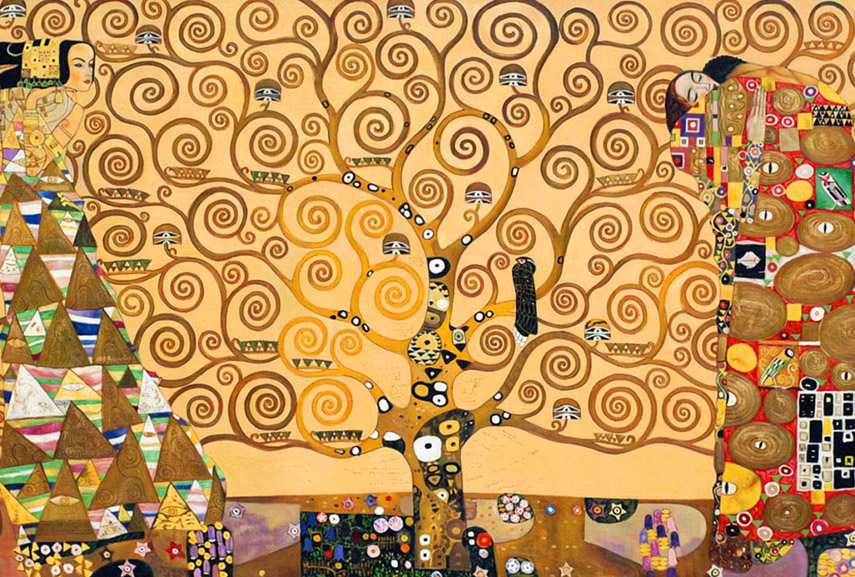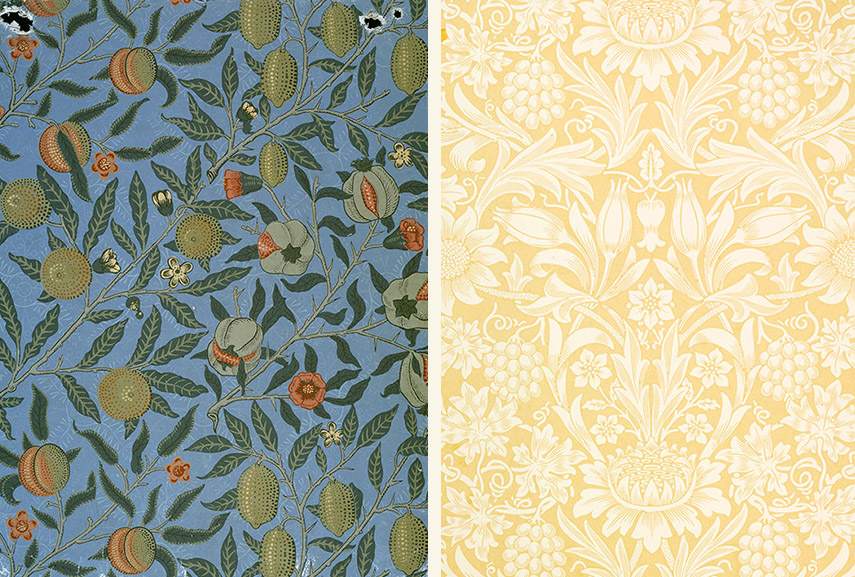What Are the Elements of a Planned Pattern in Art
Accept you e'er wondered what is blueprint in art and everyday life exactly, how it tin can exist divers and how is it unlike from repetition? Design is such a universal term that trying to define it may seem redundant. Even so, definitions are normally the ones that keep hidden knowledge and cyphered data, fifty-fifty when they give an impression of commonplaceness. That is why we'll describe the bones term in order to determine the role and definition of pattern in fine art and architecture, and see how the context affects the mode nosotros perceive it. A pattern is described as a "discernable regularity" by Wikipedia and as an "arrangement of repeated or corresponding parts" by lexicon.com. As you can already imagine, the applicability of patterns in fine art is probably as old as art itself. We simply need to visualize a temple from ancient Greece, or any of its decorative elements, to give ourselves a great blueprint art case of discernable regularity - both the facade, the plan and the decorations are related to one another and forming easily recognizable patterns.

Pattern In Nature
Nearly of usa imagine somewhat regular patterns when we hear the discussion. The association normally makes usa call up of garments, tiles and similar designed products, all of which are man-made and artificial, fifty-fifty when those art patterns tend to imitate occurrences that come from nature. Nonetheless, it'due south not wrong to say that nature has a rhythm of its own, even though recognizing its pattern takes deeper analysis and consideration. Although nature may seem, well – natural, its spontaneity is non necessarily mathematically unfathomable. Nature often follows the design of fractals, which were explained by the famous mathematician Benoit Mandelbrot in the 20th century. Fractals resemble "discernable regularity", just they include the possibility of scaling, mirroring and rotating elements, which makes the blueprint much more than complex and harder to comprehend than the simple geometric arrangements designed by humans. Nature's logic can be seen in the fashion trees branch into smaller parts that visually resemble their parent branches, or through tessellations that appear on flower petals, in foams and honeycombs. However, natural patterns are rarely entirely consistent, but much more due to the imprecise symmetry of the elements than the irregularity of the process.

How Patterns Are Translated From Nature
Paradoxically, the imperfection of nature has been desperately imitated past humans for centuries, with a brief moment of opposite logic in the 20th century, when the Modernists decided to make the most honestly industrialized objects and artworks and to celebrate the power of machines, i.e. the power of humans. On the other mitt, the idea to translate patterns from nature often resulted in producing grids and arrays that would never occur naturally. Gifted craftsmen were able to produce visually highly-seasoned pattern fine art combinations of floral or nature-derived elements that served equally decorations or embellished the garments used for apparel and furniture. Simply more often than not, these patterns couldn't escape the fact that they were shaped past a mitt that is guided by a human heed – reductive and prone to disentangle. That's why William Morris' pattern art is determinable at first glance, fifty-fifty though information technology mimics natural shapes. The other fashion to look at nature was to try to learn from its patterns – the tessellations, fractal derivations and flows, which was most cautiously studied through compages. Nonetheless, one of the first architects who truly seemed to attain the arbitrariness of nature was Gaudi, whose arroyo to architectural elements was sculptural rather than pragmatic, albeit underpinned by mathematics. Nature was by and large examined throughout the unabridged Art Nouveau catamenia in various ways, but information technology was nevertheless very clear that its patterns are vastly inimitable, at least visually.

A Existent Man-Made Kind of Repetition
The 20th century was a menses in which the most ordinary patterns were used and made as simple as possible, especially in architecture and precisely in society to make living as simple, as universal as possible. It was the historic period of the grid, in which several attempts were made to work out a universal language of visual information. De Stijl architects and artists had a vision to translate all meanings into visual patterns, using 3 elementary colors and a grid that articulates them. Bauhaus and the future Modernist movements that were more or less derived from it were all guided past the aesthetics that stemmed from the shapes and forms produced by the industry. In Modernism, patterns were used non only for facades or structural elements, such every bit columns or lintels, merely for unabridged blocks and living units. Along with the historic period of mass production, buildings became too big not to be formulated into units, and and then flats and offices were massively arranged into simple patterns. Le Corbusier used the term "machine for living in", and oh how descriptive he was.

Design In Fine art
Just regularity does not necessarily hateful orthogonal assembling, nor is the orthogonal array necessarily wearisome. Visual artists accept been deploying blueprint in fine art in numerous ways with an awareness of the effect that information technology might have on the spectator. Namely, equally we already discussed, human heed is somehow strangely satisfied when able to discern a certain rhythm (which is why we get then easily addicted to pop songs). Yet, the repetition is merely rarely fabricated besides apparent or left unaccompanied by at least one "irregularity" (which is why we go fond to popular music and not techno). All joking aside, music truly is a expert reference for analyzing pattern in art, since it could non exists without tact and rhythm - except for jazz maybe, which simply naturally occurred in the same moment as all the other revolutionary avant-garde movements in art. If we go by illustration, we could acquaintance jazz with Dada and its complete detachment from any kind of pattern and order; and we could attempt to relate Damien Hirst's spot paintings to happy electronic music, or every bit the creative person put it - "To create that structure, to do those colours, and do nothing. I of a sudden got what I wanted. It was only a manner of pinning down the joy of colour."
Meet more works past Damien Hirst here!
In between the 2 extremes that nosotros have just listed, in that location'south a myriad of artworks that use patterns here and there - in the background, for illusive optical effects, as a guideline for a practiced composition, or instead of using color and shade - well, even Pointillism could be considered to follow a sure pattern in terms of technique. Pattern in art was also widely used in applied arts, more often than not for stained glass and tapestry in the by, and for graphic pattern today. Regardless of the discipline, design is always used either as mere ornament, for its pictorial qualities, or every bit a method that incorporates structure into the design, when the process backside its use is a bit more intellectual.

Editors' Tip: Pattern Design
A beautifully illustrated guide to the employ of decorative patterns in art and blueprint explains how "the use of pattern in pattern is no haphazard matter, only a disciplined activity in which the artists must impose a pleasing order and structure on the whole to achieve an aesthetically satisfying cease product". The writer Lewis Day imagined the book as a guide to artists who wish to explore the power and the potential of unlike fine art patterns and repeated ornaments, providing an in-depth insight into the geometric backgrounds, but referring to nature and anatomy also.
Featured image: A girl in front end of one of Damien Hirst'southward spot paintings, image via Observer; Agnes Martin exhibition view at Tate Modern, prototype via Artsy; Frank Stella, Damascus Gate, 1970; Andy Warhol Soup Cans via Fourth dimension. All images used for illustrative purposes only.
hubbardwhinged1940.blogspot.com
Source: https://www.widewalls.ch/magazine/pattern-in-art
0 Response to "What Are the Elements of a Planned Pattern in Art"
Post a Comment